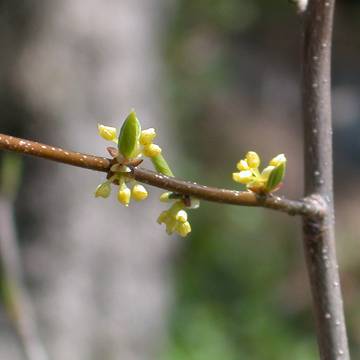

Lindera benzoin - (image 1 of 7)
Taxonomy
Family: Lauraceae
Habitat
Wet to mesic woods. Swampy woodlands
Associates
Woody associates in mesic woods include Acer saccharum, Asimina triloba, Cercis canadensis, Cornus florida, Euonymus obovatus, Fagus grandifolia, Fraxinus americana, Parthenocissus quinquefolia, Prunus serotina, Prunus virginiana, Quercus rubra, Ribes cynosbati, Tilia americana, Viburnum acerifolium.
Distribution
Morphology
Rounded or irregular deciduous shrub, to 12' high and wide. Leaves alternate, simple, entire, to 5" long and 2.5" wide, oblong-obovate, acute to short acuminate, cuneate, light green above, pale below, margins ciliate; petiole to .5" long. Stems rounded, green to olive brown with light lenticels. Flowers dioecious, pale yellow, 1.5" diameter, in clusters in axillary clusters. Fruit an oval drupe, to .5" long, green changing to orange and then bright red.
Notes
Flowers early April to late May.
Wetland indicator: Facultative wetland-
An excellent ornamental shrub for moist woods in part shade or shade. The leaves usually turn a good, clear yellow in the fall. The floral effect is good but not overwhelming, like a light version of forsythia. The fruits are attractive when abundant and were once used as a substitute for allspice. Spicebush is an important larval food plant for the spicebush swallowtail.
Bibliography
Dirr, Michael A. 1998. Manual of Woody Landscape Plants:
Their Identification, Ornamental Characteristics, Culture, Propagation and Uses.
5th ed. Champaign, Illinois: Stipes Publishing L.L.C.
Swink, F. and G. Wilhelm. 1994. Plants of the Chicago Region.
Indiana Academy of Science. The Morton Arboretum. Lisle, Illinois.
|
Michael Hough © 2005 |